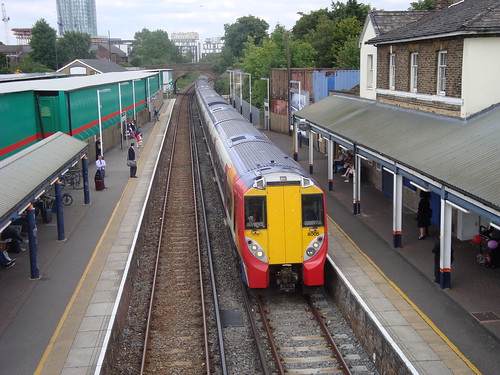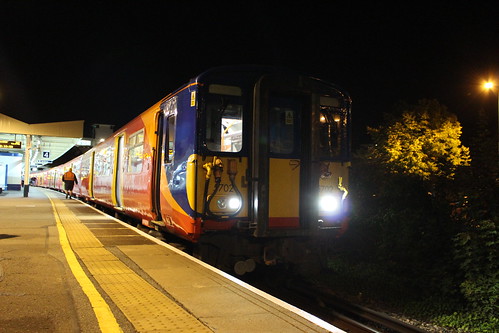The corridor of Routes 15, 115, 5 and N15 has turned over from Stagecoach to Go-Ahead London. This is one of the largest set of contracts to turn around to a different operator recently, with a total PVR of 71 (22 at night).
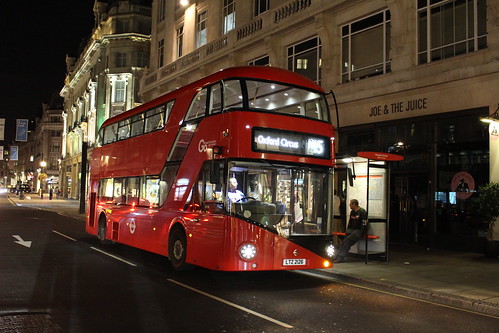
The first N15 to enter service was LT926, departing on time at Romford Market at 0020. This bus is seen finishing the first eastbound journey from Romford at Oxford Circus.
(© Aubrey)
The changeover started out on the N15, with buses supposed to be starting at 0020 from each end. Drivers were mostly ex-Stagecoach, thus were mostly route trained for the N15. Some drivers did find the section north of Trafalgar Square new to them, or at least needed refreshment in their knowledge. However, there is one very short new section on the N15, running north of Oxford Street for the first time since August 2010. However, this extension only takes it one stop past it, as it terminates by Margaret Street on Regent Street, thus serving Oxford Circus.

East London Transit branded LTs run on the N15, as most of the first night's allocation was LTs from the East London Transit allocation. LT908 is seen on the 0210 departure from Oxford Circus.
(© Aubrey)
The allocation is mostly LTs from the East London Transit routes, as well as other LTs from the 15. Route N15 automatically becomes the second-largest night route Go-Ahead London run, and is the first night route into Central London for the Blue Triangle sector. It is also the second most frequent night route on weekends that Go-Ahead London operate, at every 10 minutes. The N155 running every 9 minutes being the most frequent. However, the N15 did run every 7-8 minutes until the contract change.
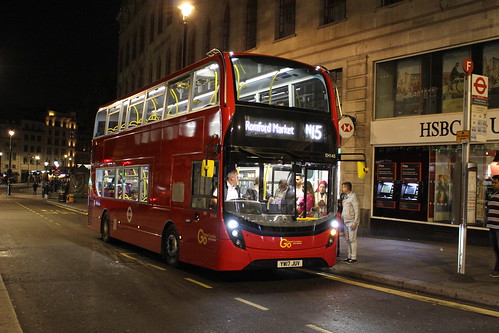
EH145 on its first ever passenger run, with the 0130 departure from Oxford Circus, seen at Charing Cross Station enroute to Romford Market.
(© Aubrey)
The other part of the N15 allocation are spares from the 5/115, which include these new E40H/Enviro 400MMCs. This is not so much of a big allocation change from the prior allocation with Stagecoach...
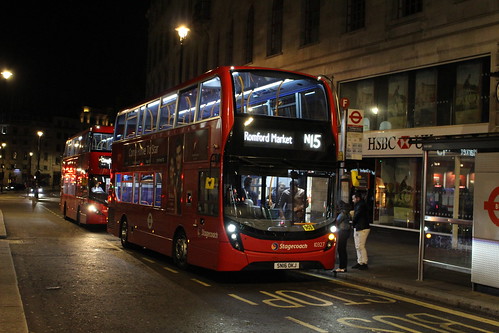
Stagecoach London 10327 on the last weekend of N15 under Stagecoach London. Spot the difference, shalt we say?
(© Aubrey)
So, for at least for the N15, there is a same-type, different operator replacement of parts of the allocation. Stagecoach did run an LT on the N15 prior to contract announcement, thus both types by Go-Ahead London so far have already been run by Stagecoach.
Although, now operated by Go-Ahead London, there is a chance that the Camberwell Night Spare bus that is used to fill gaps in the service being used on the N15. However, even that might not be so different to parts of the allocation either!
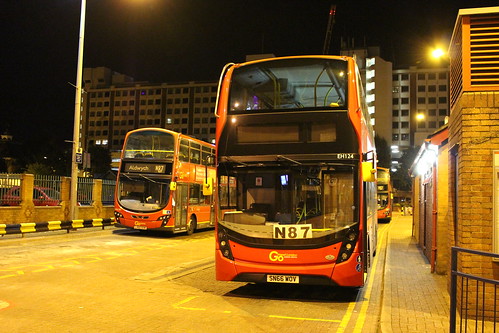
An example Camberwell Night Spare bus, EH124 on Route N87 at Kingston. This working has not happened at the time of writing yet on the N15.
(© Aubrey)
Operation of the N15 over the first two nights was good enough to not need the Camberwell Night Spare, so far. Other than some drivers having to re-remember the section between Oxford Circus and Trafalgar Square, the early part of the N15 first night went well.
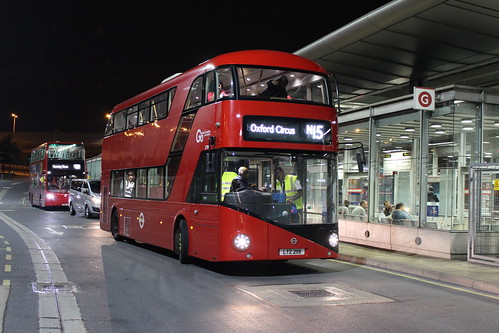
LT919 stands at Canning Town, with the driver getting instructions from a controller. And a familiar passenger!
(© Aubrey)
Route N15 started to run with erratic headways towards the end of the service of the first night, and some N15s did stand at Canning Town Bus Station for long periods of time.
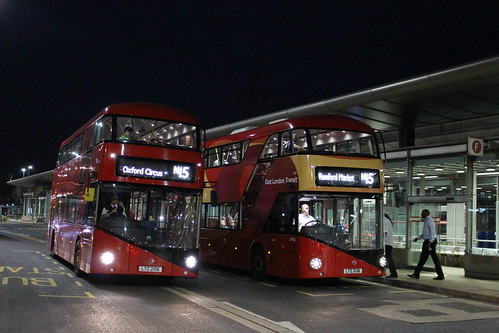
LT906 westbound passes LT936 eastbound at Canning Town Bus Station.
(© Aubrey)
Overall, the N15 ran to a decent service for the first night, and it seems the frequency decrease seems to have made not too much overcrowding. The LTs are not as bad during the night as they are during the day, and overall, it seems that Go-Ahead have gotten a grip of the N15 pretty early, pretty quickly.
Some journeys from the N15 interwork into the 5, and thus an LT ran on the first journey of Route 5.
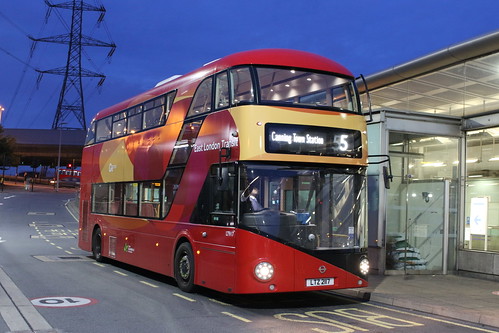
A fully blinded LT917 running the first 5 from Romford Market, seen at its last stop of the journey and of the bus's duty. The bus then ran not in service back to River Road Garage.
(© Aubrey)
The 5 turned out to be the most diverse of bus types having run on the first day, with 5 bus type codes (4 different types of buses) running on the route.
Thus, the 5 went from this:
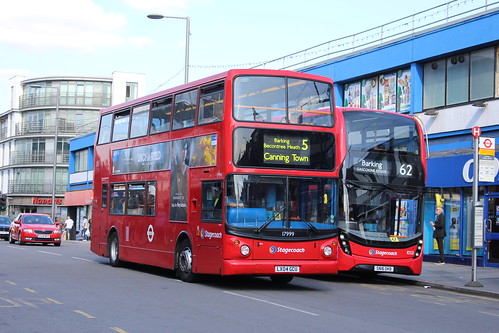
Tridents ran the main allocation of the 5, with Enviro 400s of pre-MMC and MMC types running also on the 5 under Stagecoach. Other buses that ran on the N15 also ran on the 5.
(© Aubrey)
To 4 different types of buses (5 codes):
Borismaster (LT) (seen above)
Volvo B9TL/Wright Eclipse Gemini 2 (WVN)
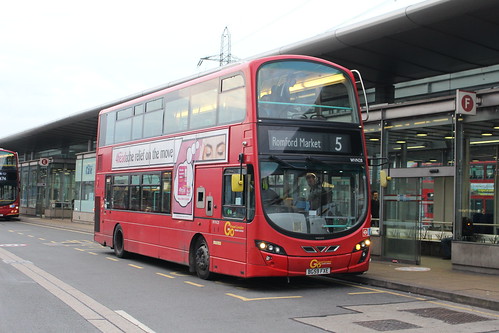
WVN28 on one of the first eastbound 5s. These WVNs are buses from the 259, recently lost to Arriva London.
(© Aubrey)
Volvo B9TL/Wright Eclipse Gemini 2 (WVL)
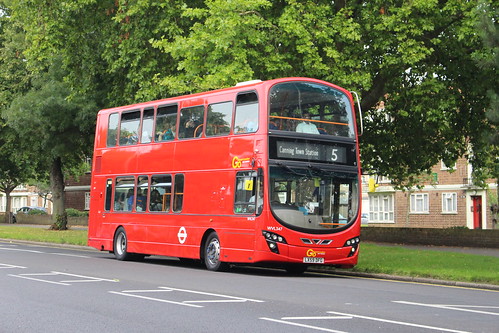
WVL347 is one of the refurbished East London Transit buses, seen along the newer part of ELT at Fair Cross, near the old base at Stagecoach of Barking Garage. Other "native" B9TLs from the 19/249 loss also run on the 5.
(© Aubrey)
Alexander-Dennis E40H/Enviro 400MMC (EH)

EH137 is one of the new hybrids allocated for the 5, as part of the 5 and all of the 115 are allocated these Enviro 400MMC hybrids. These new buses are decent to ride on whilst new certainly.
(© Aubrey)
Alexander-Dennis E40D/Enviro 400 (E)
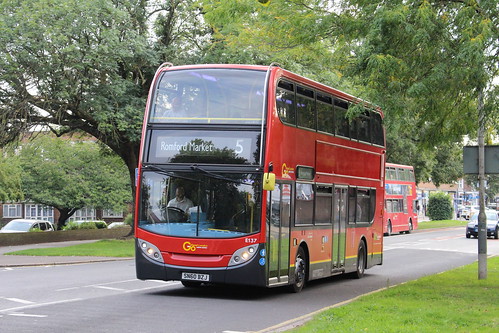
E137 is an oddity, normally allocated to other routes in River Road but being used on the 5. These strays are likely to happen.
(© Aubrey)
The 5 has been rerouted within Romford to go via Queen's Hospital. The frequency of the 5 has been cut to every 6-7 minutes, with new peak direction journeys introduced instead. However, even then, the first few journeys of the 5 and 115 were completely full. The 5 itself was not running without too many notable hitches, and all seems well.
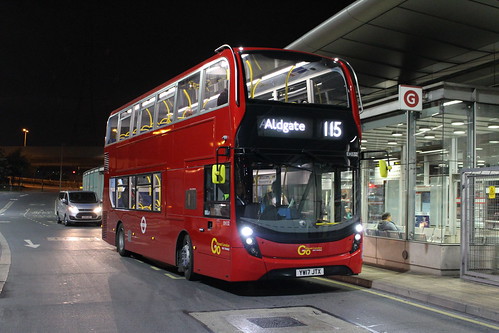
The first Blue Triangle 115 operated by EH132, seen at Canning Town Bus Station
(© Aubrey)
The 115 is deemed as the "infiller" between the 5 and the 15, having its own unique section between Canning Town and All Saints. Previously run as the 15B, the 115 only started to run on the evenings in 2003 once 15's Routemasters were withdrawn. Like the other routes, the 115 has always been with Stagecoach since privatisation. Now, it is the route with a full hybrid allocation.
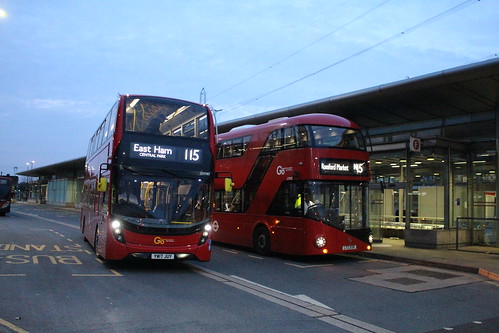
EH147 on Route 115 passes one of the last N15s of the night, operated by LT930.
(© Aubrey)
The 115 has had no notable change other than the buses and the operator. The route, although fairly busy, has had not very notable hitches over the first few days of service...except
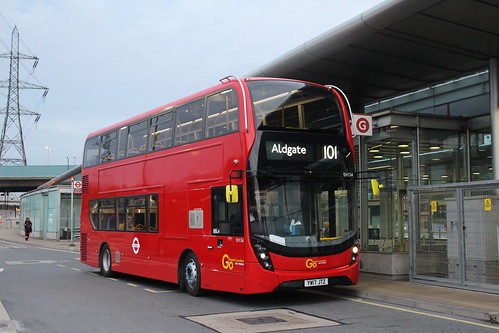
Everything there is wrong. And somehow people know it's a westbound 115. It's actually a 115 to Limehouse. The side says 101 to Beckton Alps.
(© Aubrey)
EH134 was one of the first buses to be curtailed, with it running to Limehouse. It also had a blind fault, thus it ran only to Limehouse, then ran displaying full 101 displays for East Ham on the way back!
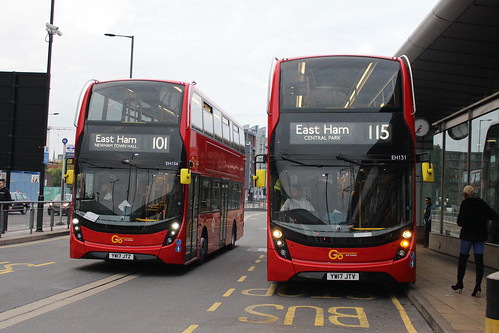
EH134 subsequently passes EH131 on its way back, running parallel yet in service displaying completely wrong blinds. EH134 needed to return to River Road for blind reprogramming.
(© Aubrey)
Some early 115s were running either with a short curtailment to East Ham, Newham Town Hall instead of Central Park, or were using the wrong East Ham blind. Either way, this was mostly solved later on in the day.
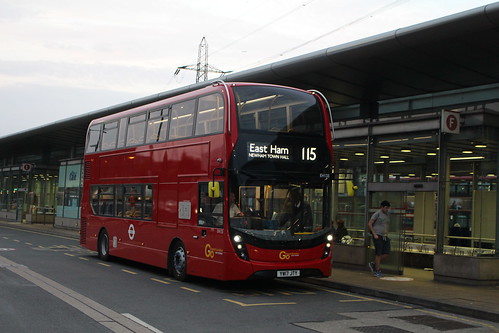
EH133 was one of the first 115s, and it was at least blinded to be curtailed a few stops early from its terminus.
(© Aubrey)
And finally, the change that was nearly no change. The 15 overnight had its buses transferred from Bow to River Road, checked over and had Blue Triangle legals added. Thus the 15 changed operator with no change overall.
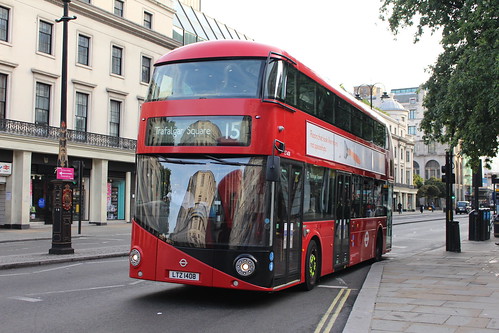
Change, but not really. LT408 transfers operator with the 15 contract and is seen under its new operator at Charing Cross Station.
(© Aubrey)
As TfL own the LTs, they can transfer the LTs between operators at will, with these being the latest to move. This is the first route to have moved with its existing buses to a different operator, permanently.
Overall, this constitutes the first big inroad Go-Ahead London has had on Stagecoach East London, with a whole corridor of routes moving to one massive River Road garage. This is also Blue Triangle's first Central London route, and first Central London night route. As with a mammoth corridor, Go-Ahead have their work cut out for the next 5-7 years.

The first N15 to enter service was LT926, departing on time at Romford Market at 0020. This bus is seen finishing the first eastbound journey from Romford at Oxford Circus.
(© Aubrey)
The changeover started out on the N15, with buses supposed to be starting at 0020 from each end. Drivers were mostly ex-Stagecoach, thus were mostly route trained for the N15. Some drivers did find the section north of Trafalgar Square new to them, or at least needed refreshment in their knowledge. However, there is one very short new section on the N15, running north of Oxford Street for the first time since August 2010. However, this extension only takes it one stop past it, as it terminates by Margaret Street on Regent Street, thus serving Oxford Circus.

East London Transit branded LTs run on the N15, as most of the first night's allocation was LTs from the East London Transit allocation. LT908 is seen on the 0210 departure from Oxford Circus.
(© Aubrey)
The allocation is mostly LTs from the East London Transit routes, as well as other LTs from the 15. Route N15 automatically becomes the second-largest night route Go-Ahead London run, and is the first night route into Central London for the Blue Triangle sector. It is also the second most frequent night route on weekends that Go-Ahead London operate, at every 10 minutes. The N155 running every 9 minutes being the most frequent. However, the N15 did run every 7-8 minutes until the contract change.

EH145 on its first ever passenger run, with the 0130 departure from Oxford Circus, seen at Charing Cross Station enroute to Romford Market.
(© Aubrey)
The other part of the N15 allocation are spares from the 5/115, which include these new E40H/Enviro 400MMCs. This is not so much of a big allocation change from the prior allocation with Stagecoach...

Stagecoach London 10327 on the last weekend of N15 under Stagecoach London. Spot the difference, shalt we say?
(© Aubrey)
So, for at least for the N15, there is a same-type, different operator replacement of parts of the allocation. Stagecoach did run an LT on the N15 prior to contract announcement, thus both types by Go-Ahead London so far have already been run by Stagecoach.
Although, now operated by Go-Ahead London, there is a chance that the Camberwell Night Spare bus that is used to fill gaps in the service being used on the N15. However, even that might not be so different to parts of the allocation either!

An example Camberwell Night Spare bus, EH124 on Route N87 at Kingston. This working has not happened at the time of writing yet on the N15.
(© Aubrey)
Operation of the N15 over the first two nights was good enough to not need the Camberwell Night Spare, so far. Other than some drivers having to re-remember the section between Oxford Circus and Trafalgar Square, the early part of the N15 first night went well.

LT919 stands at Canning Town, with the driver getting instructions from a controller. And a familiar passenger!
(© Aubrey)
Route N15 started to run with erratic headways towards the end of the service of the first night, and some N15s did stand at Canning Town Bus Station for long periods of time.

LT906 westbound passes LT936 eastbound at Canning Town Bus Station.
(© Aubrey)
Overall, the N15 ran to a decent service for the first night, and it seems the frequency decrease seems to have made not too much overcrowding. The LTs are not as bad during the night as they are during the day, and overall, it seems that Go-Ahead have gotten a grip of the N15 pretty early, pretty quickly.
Some journeys from the N15 interwork into the 5, and thus an LT ran on the first journey of Route 5.

A fully blinded LT917 running the first 5 from Romford Market, seen at its last stop of the journey and of the bus's duty. The bus then ran not in service back to River Road Garage.
(© Aubrey)
The 5 turned out to be the most diverse of bus types having run on the first day, with 5 bus type codes (4 different types of buses) running on the route.
Thus, the 5 went from this:

Tridents ran the main allocation of the 5, with Enviro 400s of pre-MMC and MMC types running also on the 5 under Stagecoach. Other buses that ran on the N15 also ran on the 5.
(© Aubrey)
To 4 different types of buses (5 codes):
Borismaster (LT) (seen above)
Volvo B9TL/Wright Eclipse Gemini 2 (WVN)

WVN28 on one of the first eastbound 5s. These WVNs are buses from the 259, recently lost to Arriva London.
(© Aubrey)
Volvo B9TL/Wright Eclipse Gemini 2 (WVL)

WVL347 is one of the refurbished East London Transit buses, seen along the newer part of ELT at Fair Cross, near the old base at Stagecoach of Barking Garage. Other "native" B9TLs from the 19/249 loss also run on the 5.
(© Aubrey)
Alexander-Dennis E40H/Enviro 400MMC (EH)

EH137 is one of the new hybrids allocated for the 5, as part of the 5 and all of the 115 are allocated these Enviro 400MMC hybrids. These new buses are decent to ride on whilst new certainly.
(© Aubrey)
Alexander-Dennis E40D/Enviro 400 (E)

E137 is an oddity, normally allocated to other routes in River Road but being used on the 5. These strays are likely to happen.
(© Aubrey)
The 5 has been rerouted within Romford to go via Queen's Hospital. The frequency of the 5 has been cut to every 6-7 minutes, with new peak direction journeys introduced instead. However, even then, the first few journeys of the 5 and 115 were completely full. The 5 itself was not running without too many notable hitches, and all seems well.

The first Blue Triangle 115 operated by EH132, seen at Canning Town Bus Station
(© Aubrey)
The 115 is deemed as the "infiller" between the 5 and the 15, having its own unique section between Canning Town and All Saints. Previously run as the 15B, the 115 only started to run on the evenings in 2003 once 15's Routemasters were withdrawn. Like the other routes, the 115 has always been with Stagecoach since privatisation. Now, it is the route with a full hybrid allocation.

EH147 on Route 115 passes one of the last N15s of the night, operated by LT930.
(© Aubrey)
The 115 has had no notable change other than the buses and the operator. The route, although fairly busy, has had not very notable hitches over the first few days of service...except

Everything there is wrong. And somehow people know it's a westbound 115. It's actually a 115 to Limehouse. The side says 101 to Beckton Alps.
(© Aubrey)
EH134 was one of the first buses to be curtailed, with it running to Limehouse. It also had a blind fault, thus it ran only to Limehouse, then ran displaying full 101 displays for East Ham on the way back!

EH134 subsequently passes EH131 on its way back, running parallel yet in service displaying completely wrong blinds. EH134 needed to return to River Road for blind reprogramming.
(© Aubrey)
Some early 115s were running either with a short curtailment to East Ham, Newham Town Hall instead of Central Park, or were using the wrong East Ham blind. Either way, this was mostly solved later on in the day.

EH133 was one of the first 115s, and it was at least blinded to be curtailed a few stops early from its terminus.
(© Aubrey)
And finally, the change that was nearly no change. The 15 overnight had its buses transferred from Bow to River Road, checked over and had Blue Triangle legals added. Thus the 15 changed operator with no change overall.

Change, but not really. LT408 transfers operator with the 15 contract and is seen under its new operator at Charing Cross Station.
(© Aubrey)
As TfL own the LTs, they can transfer the LTs between operators at will, with these being the latest to move. This is the first route to have moved with its existing buses to a different operator, permanently.
Overall, this constitutes the first big inroad Go-Ahead London has had on Stagecoach East London, with a whole corridor of routes moving to one massive River Road garage. This is also Blue Triangle's first Central London route, and first Central London night route. As with a mammoth corridor, Go-Ahead have their work cut out for the next 5-7 years.

